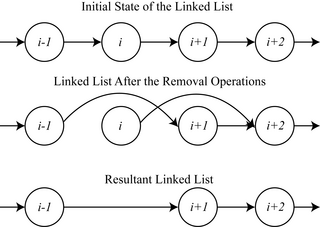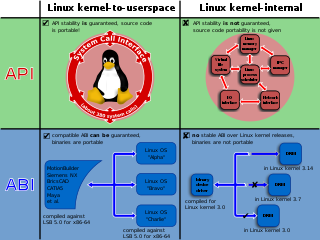
In computing, multitasking is the concurrent execution of multiple tasks over a certain period of time. New tasks can interrupt already started ones before they finish, instead of waiting for them to end. As a result, a computer executes segments of multiple tasks in an interleaved manner, while the tasks share common processing resources such as central processing units (CPUs) and main memory. Multitasking automatically interrupts the running program, saving its state and loading the saved state of another program and transferring control to it. This "context switch" may be initiated at fixed time intervals, or the running program may be coded to signal to the supervisory software when it can be interrupted.
A real-time operating system (RTOS) is an operating system (OS) for real-time computing applications that processes data and events that have critically defined time constraints. An RTOS is distinct from a time-sharing operating system, such as Unix, which manages the sharing of system resources with a scheduler, data buffers, or fixed task prioritization in multitasking or multiprogramming environments. All operations must verifiably complete within given time and resource constraints or else fail safe. Real-time operating systems are event-driven and preemptive, meaning the OS can monitor the relevant priority of competing tasks, and make changes to the task priority. Event-driven systems switch between tasks based on their priorities, while time-sharing systems switch the task based on clock interrupts.
On Unix and Unix-like computer operating systems, a zombie process or defunct process is a process that has completed execution but still has an entry in the process table: it is a process in the "terminated state". This occurs for the child processes, where the entry is still needed to allow the parent process to read its child's exit status: once the exit status is read via the wait system call, the zombie's entry is removed from the process table and it is said to be "reaped". A child process initially becomes a zombie, only then being removed from the resource table. Under normal system operation, zombies are immediately waited on by their parent and then reaped by the system. Processes that stay zombies for a long time are usually an error and can cause a resource leak. Generally, the only kernel resource they occupy is the process table entry, their process ID. However, zombies can also hold buffers open, consuming memory. Zombies can hold handles to file descriptors, which prevents the space for those files from being available to the filesystem. This effect can be seen by a difference between du and df. While du may show a large amount of free disk space, df will show a full partition. If the zombies are not cleaned, this can fill the root partition and crash the system.

In computer science, mutual exclusion is a property of concurrency control, which is instituted for the purpose of preventing race conditions. It is the requirement that one thread of execution never enters a critical section while a concurrent thread of execution is already accessing said critical section, which refers to an interval of time during which a thread of execution accesses a shared resource or shared memory.

In computing, a process is the instance of a computer program that is being executed by one or many threads. There are many different process models, some of which are light weight, but almost all processes are rooted in an operating system (OS) process which comprises the program code, assigned system resources, physical and logical access permissions, and data structures to initiate, control and coordinate execution activity. Depending on the OS, a process may be made up of multiple threads of execution that execute instructions concurrently.

In computing, a system call is the programmatic way in which a computer program requests a service from the operating system on which it is executed. This may include hardware-related services, creation and execution of new processes, and communication with integral kernel services such as process scheduling. System calls provide an essential interface between a process and the operating system.
In computing, particularly in the context of the Unix operating system and its workalikes, fork is an operation whereby a process creates a copy of itself. It is an interface which is required for compliance with the POSIX and Single UNIX Specification standards. It is usually implemented as a C standard library wrapper to the fork, clone, or other system calls of the kernel. Fork is the primary method of process creation on Unix-like operating systems.
A child process in computing is a process created by another process. This technique pertains to multitasking operating systems, and is sometimes called a subprocess or traditionally a subtask.
In computing, a parent process is a process that has created one or more child processes.

In multitasking computer operating systems, a daemon is a computer program that runs as a background process, rather than being under the direct control of an interactive user. Traditionally, the process names of a daemon end with the letter d, for clarification that the process is in fact a daemon, and for differentiation between a daemon and a normal computer program. For example, syslogd is a daemon that implements system logging facility, and sshd is a daemon that serves incoming SSH connections.
In concurrent programming, concurrent accesses to shared resources can lead to unexpected or erroneous behavior. Thus, the parts of the program where the shared resource is accessed need to be protected in ways that avoid the concurrent access. One way to do so is known as a critical section or critical region. This protected section cannot be entered by more than one process or thread at a time; others are suspended until the first leaves the critical section. Typically, the critical section accesses a shared resource, such as a data structure, peripheral device, or network connection, that would not operate correctly in the context of multiple concurrent accesses.
A process control block (PCB), also sometimes called a process descriptor, is a data structure used by a computer operating system to store all the information about a process.
Signals are standardized messages sent to a running program to trigger specific behavior, such as quitting or error handling. They are a limited form of inter-process communication (IPC), typically used in Unix, Unix-like, and other POSIX-compliant operating systems.
In computing, the exit status of a terminated process is an integer number that is made available to its parent process. In DOS, this may be referred to as an errorlevel.
Fork–exec is a commonly used technique in Unix whereby an executing process spawns a new program.

In a multitasking computer system, processes may occupy a variety of states. These distinct states may not be recognized as such by the operating system kernel. However, they are a useful abstraction for the understanding of processes.
In Unix and Unix-like operating systems, job control refers to control of jobs by a shell, especially interactively, where a "job" is a shell's representation for a process group. Basic job control features are the suspending, resuming, or terminating of all processes in the job/process group; more advanced features can be performed by sending signals to the job. Job control is of particular interest in Unix due to its multiprocessing, and should be distinguished from job control generally, which is frequently applied to sequential execution.
On many computer operating systems, a computer process terminates its execution by making an exit system call. More generally, an exit in a multithreading environment means that a thread of execution has stopped running. For resource management, the operating system reclaims resources that were used by the process. The process is said to be a dead process after it terminates.
A computer program may sleep, which places it into an inactive state for a period of time. Eventually the expiration of an interval timer, or the receipt of a signal or interrupt causes the program to resume execution.

A process is a program in execution, and an integral part of any modern-day operating system (OS). The OS must allocate resources to processes, enable processes to share and exchange information, protect the resources of each process from other processes and enable synchronization among processes. To meet these requirements, The OS must maintain a data structure for each process, which describes the state and resource ownership of that process, and which enables the operating system to exert control over each process.






